
An acid is titrated with NaOH. The following beakers are illustrations of the contents of the beaker at various times during the titration. These are presented out of order. Note: Counter-ions and water molecules have been omitted from the illustrations for clarity.
(a) 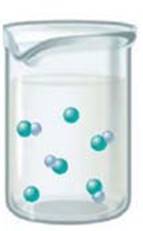
(b) 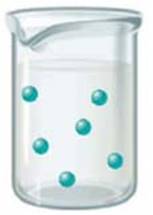
(c) 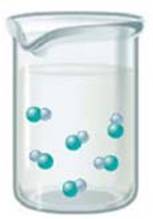
(d) 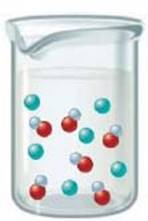
(e) 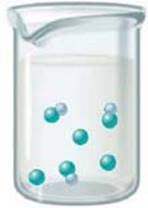
a. Is the acid a weak or strong acid? How can you tell?
b. Arrange the beakers in order of what the contents would look like as the titration progresses.
c. For which beaker would pH = pKa? Explain your answer.
d. Which beaker represents the equivalence point of the titration? Explain your answer.
e. For which beaker would the Ka value for the acid not be necessary to determine the pH? Explain your answer.
Trending nowThis is a popular solution!

Chapter 14 Solutions
Chemistry: An Atoms First Approach
Additional Science Textbook Solutions
Chemistry: The Molecular Nature of Matter
Principles of General, Organic, Biological Chemistry
Inorganic Chemistry
Chemistry
General, Organic, and Biological Chemistry - 4th edition
Chemistry: A Molecular Approach
- A bottle of concentrated hydroiodic acid is 57% HI by weight and has a density of 1.70 g/mL. A solution of this strong and corrosive acid is made by adding exactly 10.0 mL to some water and diluting to 250.0 mL. If the information on the label is correct, what volume of 0.988 M NaOH is needed to neutralize the HI solution? Suggest an indicator for the titration.arrow_forwardExplain why the hydrolysis of salts makes it necessary to have available in a laboratory more than one acid-base indicator for use in titrations.arrow_forwardSketch the titration curve for a weak acid titrated by a strong base. When performing calculations concerning weak acidstrong base titrations, the general two-slep procedure is to solve a stoichiometry problem first, then to solve an equilibrium problem to determine the pH. What reaction takes place in the stoichiometry part of the problem? What is assumed about this reaction? At the various points in your titration curve, list the major species present after the strong base (NaOH, for example) reacts to completion with the weak acid, HA. What equilibrium problem would you solve at the various points in your titration curve to calculate the pH? Why is pH 7.0 at the equivalence point of a weak acid-strong base titration? Does the pH at the halfway point to equivalence have to be less than 7.0? What does the pH at the halfway point equal? Compare and contrast the titration curves for a strong acidstrong base titration and a weak acidstrong base titration.arrow_forward
- Consider the titration of HF (K a=6.7104) with NaOH. What is the pH when a third of the acid has been neutralized?arrow_forward. Which component of a buffered solution is capable of combining with an added strong acid? Using your example from Exercise 60, show how this component would react with added HC1.arrow_forwardA solution is made by diluting 25.0 mL of concentrated HCl (37% by weight; density = 1.19 g/mL) to exactly 500 mL. Calculate the pH of the resulting solution.arrow_forward
- a buffer solution is often encountered during the titration of aweak acid. In such a titration, there is a strong base (often sodium hydroxide, as in today’s lab)which is being added to the weak acid. When the strong base reacts with the weak acid, theresult is the conjugate base of the weak acid. It is essential that you not confuse these twobases during the discussion below, and that you write your report so that it is clear which baseyou are talking about. If the pH of the acid solution is monitored during the titration, a pHprofile like the one below can be plotted. For monoprotic acids it will be sigmoid in shape:The Henderson-Hasselbalch equation helps to make sense of this curve (the base referredto is the conjugate base of the weak acid).pH = pKa + log ([base]/[acid])If calculations are desired, two points are particularly important. The first, at the steepest pointof the graph, is the equivalence point. At that point the acid has been completely consumed bythe strong base…arrow_forwarda buffer solution is often encountered during the titration of aweak acid. In such a titration, there is a strong base (often sodium hydroxide, as in today’s lab)which is being added to the weak acid. When the strong base reacts with the weak acid, theresult is the conjugate base of the weak acid. It is essential that you not confuse these twobases during the discussion below, and that you write your report so that it is clear which baseyou are talking about. If the pH of the acid solution is monitored during the titration, a pHprofile like the one below can be plotted. For monoprotic acids it will be sigmoid in shape:The Henderson-Hasselbalch equation helps to make sense of this curve (the base referredto is the conjugate base of the weak acid).pH = pKa + log ([base]/[acid])If calculations are desired, two points are particularly important. The first, at the steepest pointof the graph, is the equivalence point. At that point the acid has been completely consumed bythe strong base…arrow_forwardA 6.25−g quantity of a diprotic acid was dissolved in water and made up to exactly 275 mL. Calculate the molar mass of the acid if 25.0 mL of this solution required 11.9 mL of 1.00 M KOH for neutralization. Assume that both protons of the acid were titrated. g/molarrow_forward
- 10. One characteristic of blood that we rarely give a thought to is its pH. The pH of blood must be held remarkably constant, varying only by a few hundredths of a pH unit from 7.36 to 7.40. Blood pH is kept constant primarily through the buffering action of the bicarbonate ion, HCO3-, and dissolved carbon dioxide, commonly represented as H2CO3. The second ionization is negligible in blood so that H2CO3 can be treated as a monoprotic acid. A) If the Ka1 for H2CO3 is 4.2 * 10-7, what ratio of HCO3- to H2CO3 is necessary to produce a buffer of pH 7.40? B) What is the pH of a buffer that is 1.0 M NaHCO3 and 1.0 M H2CO3? C) If you have 1.00 L of the buffer described above (1.0 M NaHCO3 and 1.0 M H2CO3) and 10.0 mL of 0.100 M HCl is added to it, what is the new pH? D) Just to prove that the buffer helps minimize changes in pH, calculate the pH of a solution prepared by adding 10.0 mL of 0.1 M HCl to 1.00 L of pure water.arrow_forwardSodium hydroxide (NaOH) is a reagent in the form of crystals and is highly hygroscopic. It is advisable to standardize it when it is desired to use it in acid standardization solutions. Knowing that 12g of the base (NaOH) were used to prepare 1L of solution, determine the actual concentration of the solution (NaOH) for a 50mL sample where 55 mL of 0.3N hydrochloric acid were used, and the volume of the said base to prepare 1L of 0.01N solution. (Data: Molar Mass of NaOH = 40.0g/mol).arrow_forward4. What does a permanent faint pink color in the solution indicate in the concept of Acid-base titration?arrow_forward

 Chemistry: An Atoms First ApproachChemistryISBN:9781305079243Author:Steven S. Zumdahl, Susan A. ZumdahlPublisher:Cengage Learning
Chemistry: An Atoms First ApproachChemistryISBN:9781305079243Author:Steven S. Zumdahl, Susan A. ZumdahlPublisher:Cengage Learning ChemistryChemistryISBN:9781305957404Author:Steven S. Zumdahl, Susan A. Zumdahl, Donald J. DeCostePublisher:Cengage Learning
ChemistryChemistryISBN:9781305957404Author:Steven S. Zumdahl, Susan A. Zumdahl, Donald J. DeCostePublisher:Cengage Learning Chemistry: Principles and PracticeChemistryISBN:9780534420123Author:Daniel L. Reger, Scott R. Goode, David W. Ball, Edward MercerPublisher:Cengage Learning
Chemistry: Principles and PracticeChemistryISBN:9780534420123Author:Daniel L. Reger, Scott R. Goode, David W. Ball, Edward MercerPublisher:Cengage Learning Principles of Modern ChemistryChemistryISBN:9781305079113Author:David W. Oxtoby, H. Pat Gillis, Laurie J. ButlerPublisher:Cengage Learning
Principles of Modern ChemistryChemistryISBN:9781305079113Author:David W. Oxtoby, H. Pat Gillis, Laurie J. ButlerPublisher:Cengage Learning





